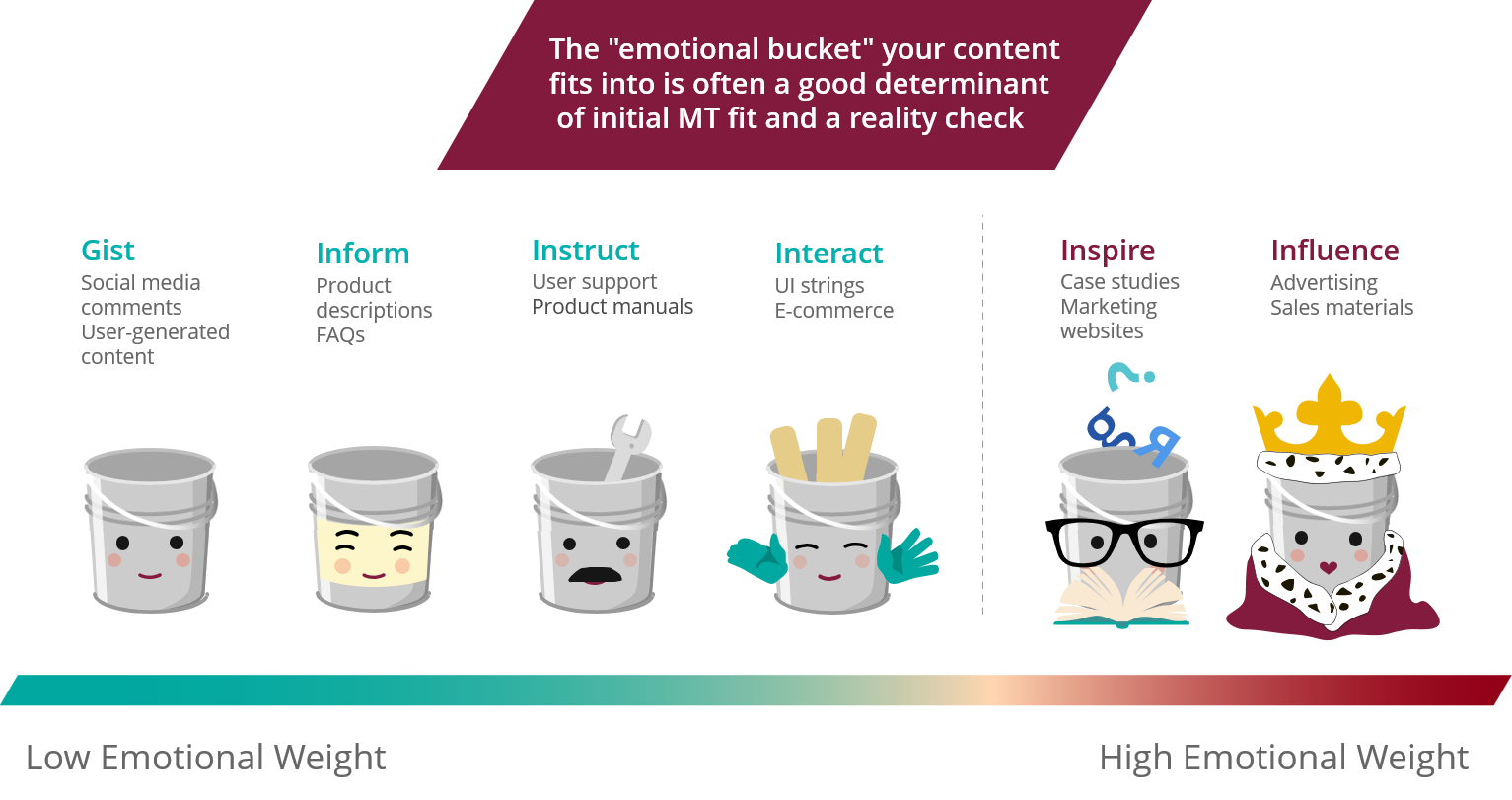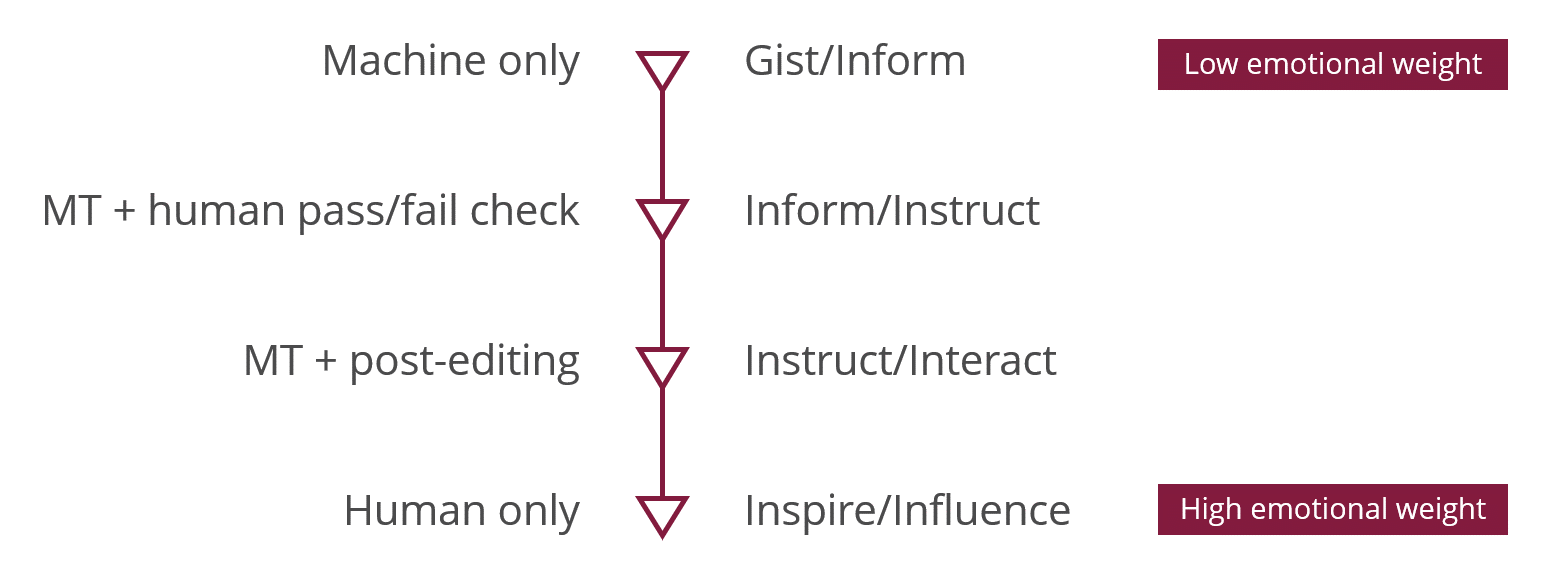Machine Translation and the Scale of Emotional Weight
04 Feb 2020


You’ve heard of machine translation (MT) and the benefits it can bring in terms of faster turnaround and lower cost. But an important thing to note is that it is not suitable for translating all types of content. So, is it suitable for yours?
It turns out there’s a simple way to decide. In this post, we’ll boil down the framework we use to assess whether our clients’ content is suitable for MT: the scale of emotional weight.
 The higher the emotional weight, the riskier it is to rely on MT alone (or at all).
The higher the emotional weight, the riskier it is to rely on MT alone (or at all).
 Gist and Inform contents are prime material for MT because the audience needs only a general understanding of their meaning. Speed is often more important than quality in these areas. Interact marks the point on the scale when humans start to become critical—in this case, to ensuring users can navigate experiences without any friction.
And beyond that, if you really want to resonate with your audience, you’re better off avoiding MT altogether.
Sure, you could use a combination approach such as MT, human post-editing and user testing (seeing how real users interact with and react to the content) to bring machine output up to a publishable, frictionless standard. But when you compare the costs of combining those three activities with human translation alone, you’re often better off assigning professionals to transcreate your content or create it from scratch in-market.
Gist and Inform contents are prime material for MT because the audience needs only a general understanding of their meaning. Speed is often more important than quality in these areas. Interact marks the point on the scale when humans start to become critical—in this case, to ensuring users can navigate experiences without any friction.
And beyond that, if you really want to resonate with your audience, you’re better off avoiding MT altogether.
Sure, you could use a combination approach such as MT, human post-editing and user testing (seeing how real users interact with and react to the content) to bring machine output up to a publishable, frictionless standard. But when you compare the costs of combining those three activities with human translation alone, you’re often better off assigning professionals to transcreate your content or create it from scratch in-market.
The scale of emotional weight
When assessing whether a piece of content is a good candidate for machine translation, the first thing you want to do is analyze the content’s purpose—in other words, its “emotional weight.” What level of emotion should the content stir in your audience, if any? The more informational or emotionally neutral your content—that is, it’s meant to inform and educate, not influence the reader to take an action—the more conducive it is to MT. That’s because the technology is not yet advanced enough to be able to reliably interpret or convey emotions. What’s more, it’s risky to rely on a machine alone to translate things like grammar and sentence structure 100% accurately. So, the more engaging or nuanced your content needs to be, the more you need humans to translate the content themselves. Let’s look at each “emotional bucket” in more depth so you can see what we mean:| Content Purpose | Definition | Example Content Types |
| Gist | The first two types of content have no emotional weight. Their purpose is to provide readers with quick information. Often, it’s user-generated or occurs in real-time environments. | social media posts/comments, blog comments/forums, live chats/IMs, user reviews |
| Inform | product descriptions, knowledge bases, FAQs, alerts/notifications | |
| Instruct | The content’s purpose is to provide explanations or instructions in plain, emotion-free language. | user support, instruction manuals, HR policies and procedures, generic internal communications and corporate emails |
| Interact | The content contains user interface elements that lead users through an experience, like adding a product to a shopping cart. | e-commerce websites, software or mobile app user interfaces, surveys, polls, assessments, quizzes, self-service content |
| Inspire | Marketing, advertising, sales and other public-facing content with legal, financial or brand implications that must speak to specific audiences directly. It’s highly targeted and thus requires high quality—usually a human-only process. | case studies, blog posts, HR materials for recruiting or training, marketing websites, culture-specific or important internal communications and corporate emails |
| Influence | taglines, advertising, legally binding material, client-facing sales collateral |
 The higher the emotional weight, the riskier it is to rely on MT alone (or at all).
The higher the emotional weight, the riskier it is to rely on MT alone (or at all).
Choosing the right translation approach
You’ll probably find, like most companies, that the majority of your content falls into the first three categories. That means you can use MT for at least most of your content. But it’s not quite as simple as deciding whether you can use MT or not. There are four distinct translation approaches:- Machine translation only. As MT advances, it becomes more capable of handling certain content types on its own. But while the technology is still advancing and improving, it should be used only on low-risk content that doesn’t have to be perfect and where there are no legal consequences.
- Machine translation + human pass/fail check. For higher-risk content that must be translated quickly, MT might be usable, but requires a quick sanity check (against a defined checklist of acceptable vs. unacceptable errors) to confirm whether it passed or failed. If the output doesn’t meet your defined expectations for quality, you take it to the next level of human input:
- Machine translation + human post-editing. After the machine has done the bulk of the work, a post-editor goes in to bring the text up to your desired quality. This works well for content that needs a human touch, but is a way for translators to handle higher volumes than if they had to translate everything from scratch.
- Human translation only. Humans do the bulk of the work, usually with the help of technologies that boost translation efficiency like CAT tools. This is the only option for content of higher emotional weight than MT is advanced enough to handle.
 Gist and Inform contents are prime material for MT because the audience needs only a general understanding of their meaning. Speed is often more important than quality in these areas. Interact marks the point on the scale when humans start to become critical—in this case, to ensuring users can navigate experiences without any friction.
And beyond that, if you really want to resonate with your audience, you’re better off avoiding MT altogether.
Sure, you could use a combination approach such as MT, human post-editing and user testing (seeing how real users interact with and react to the content) to bring machine output up to a publishable, frictionless standard. But when you compare the costs of combining those three activities with human translation alone, you’re often better off assigning professionals to transcreate your content or create it from scratch in-market.
Gist and Inform contents are prime material for MT because the audience needs only a general understanding of their meaning. Speed is often more important than quality in these areas. Interact marks the point on the scale when humans start to become critical—in this case, to ensuring users can navigate experiences without any friction.
And beyond that, if you really want to resonate with your audience, you’re better off avoiding MT altogether.
Sure, you could use a combination approach such as MT, human post-editing and user testing (seeing how real users interact with and react to the content) to bring machine output up to a publishable, frictionless standard. But when you compare the costs of combining those three activities with human translation alone, you’re often better off assigning professionals to transcreate your content or create it from scratch in-market.
Final thoughts on assessing your content’s MT fit
There certainly is value in letting machines do the busywork and leaving the polish and creativity to the experts. MT might allow you to translate content that would otherwise remain in the source language due to budget restrictions, and with a quality level that is fit for purpose. But the benefits apply only if the net result is faster or more affordable than leaving MT out of the picture entirely. So, how do you know which translation approach to take for what content? Is your translation budget best spent on humans, machines or a mix of both? Talk to your translation provider. They can help you:- Define what content is viable for MT
- Choose the engines best suited to your business needs
- Deploy your MT program, then optimize your investment over time

